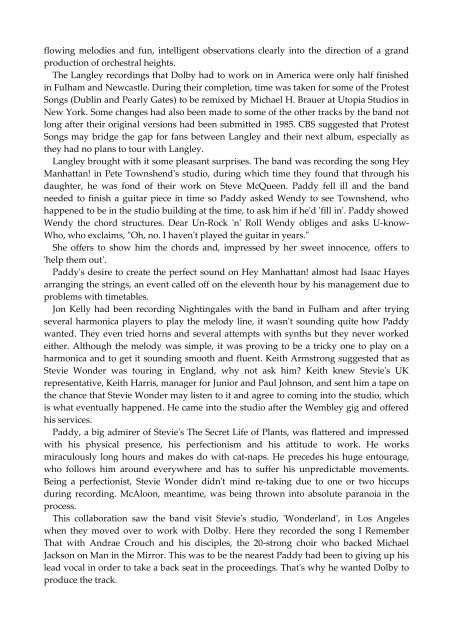MYTHS, MELODIES & METAPHYSICS: - Prefab Sprout
MYTHS, MELODIES & METAPHYSICS: - Prefab Sprout
MYTHS, MELODIES & METAPHYSICS: - Prefab Sprout
Create successful ePaper yourself
Turn your PDF publications into a flip-book with our unique Google optimized e-Paper software.
flowing melodies and fun, intelligent observations clearly into the direction of a grand<br />
production of orchestral heights.<br />
The Langley recordings that Dolby had to work on in America were only half finished<br />
in Fulham and Newcastle. During their completion, time was taken for some of the Protest<br />
Songs (Dublin and Pearly Gates) to be remixed by Michael H. Brauer at Utopia Studios in<br />
New York. Some changes had also been made to some of the other tracks by the band not<br />
long after their original versions had been submitted in 1985. CBS suggested that Protest<br />
Songs may bridge the gap for fans between Langley and their next album, especially as<br />
they had no plans to tour with Langley.<br />
Langley brought with it some pleasant surprises. The band was recording the song Hey<br />
Manhattan! in Pete Townshend's studio, during which time they found that through his<br />
daughter, he was fond of their work on Steve McQueen. Paddy fell ill and the band<br />
needed to finish a guitar piece in time so Paddy asked Wendy to see Townshend, who<br />
happened to be in the studio building at the time, to ask him if he'd 'fill in'. Paddy showed<br />
Wendy the chord structures. Dear Un-Rock 'n' Roll Wendy obliges and asks U-know-<br />
Who, who exclaims, "Oh, no. I haven't played the guitar in years."<br />
She offers to show him the chords and, impressed by her sweet innocence, offers to<br />
'help them out'.<br />
Paddy's desire to create the perfect sound on Hey Manhattan! almost had Isaac Hayes<br />
arranging the strings, an event called off on the eleventh hour by his management due to<br />
problems with timetables.<br />
Jon Kelly had been recording Nightingales with the band in Fulham and after trying<br />
several harmonica players to play the melody line, it wasn't sounding quite how Paddy<br />
wanted. They even tried horns and several attempts with synths but they never worked<br />
either. Although the melody was simple, it was proving to be a tricky one to play on a<br />
harmonica and to get it sounding smooth and fluent. Keith Armstrong suggested that as<br />
Stevie Wonder was touring in England, why not ask him? Keith knew Stevie's UK<br />
representative, Keith Harris, manager for Junior and Paul Johnson, and sent him a tape on<br />
the chance that Stevie Wonder may listen to it and agree to coming into the studio, which<br />
is what eventually happened. He came into the studio after the Wembley gig and offered<br />
his services.<br />
Paddy, a big admirer of Stevie's The Secret Life of Plants, was flattered and impressed<br />
with his physical presence, his perfectionism and his attitude to work. He works<br />
miraculously long hours and makes do with cat-naps. He precedes his huge entourage,<br />
who follows him around everywhere and has to suffer his unpredictable movements.<br />
Being a perfectionist, Stevie Wonder didn't mind re-taking due to one or two hiccups<br />
during recording. McAloon, meantime, was being thrown into absolute paranoia in the<br />
process.<br />
This collaboration saw the band visit Stevie's studio, 'Wonderland', in Los Angeles<br />
when they moved over to work with Dolby. Here they recorded the song I Remember<br />
That with Andrae Crouch and his disciples, the 20-strong choir who backed Michael<br />
Jackson on Man in the Mirror. This was to be the nearest Paddy had been to giving up his<br />
lead vocal in order to take a back seat in the proceedings. That's why he wanted Dolby to<br />
produce the track.


